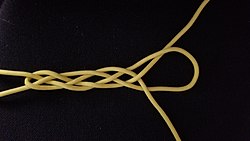Creeton Saxon Stone West Face
Größe:
612 x 816 Pixel (462992 Bytes)
Beschreibung:
Anglo-Saxon/Romanesque carving on free-standing slab at St Peter's church, Creeton, Lincolnshire, UK. The stone was found when taking down the old walls of Creeton church in 1856-57. The slightly tapered stone, standing 1.66 m tall, has been variously described as part of a Saxon cross-shaft or a grave cover (in which case it would have originally laid flat). This photo shows only the west-facing face of the slab. Its east face bore a similar design but it was partly cut away when the stone was used as a lintel. The northern face (originally the top) is wider, and has a complex pattern of two large roundels consisting of two concentric rings of saltire crosses around a central flat disk; between the roundels are two panels of saltire crosses. The style of this carving suggests that this face of the stone was re-cut in the 12th century, possibly at the time that it was used as a lintel. According to
CRSBI (The Corpus of Romanesque Sculpture in Britain and Ireland) the slab is one of the most complete examples of the Anglo-Saxon, Mid-Kesteven type of grave cover in Lincolnshire.
Kommentar zur Lizenz:
Own work, all rights released. This version of the image is in the Public Domain. If it is used outside Wikipedia, a photographer's credit (Simon Garbutt) would be appreciated!
Credit:
Selbst fotografiert
Weitere Informationen zur Lizenz des Bildes finden Sie hier. Letzte Aktualisierung: Tue, 16 Aug 2022 03:53:12 GMT
Relevante Bilder
Relevante Artikel
Trossenstek
Der Trossenstek ist ein Verbindungs-, aber auch Zierknoten, mit dem sich zwei Enden verbinden lassen. Er wird als Schifferknoten bei dickeren Seilen (Trossen) verwendet, aber auch wenn Leinen großen Belastungen oder Durchnässung ausgesetzt werden. Der reguläre Trossenstek wird als sehr sicherer Verbindungsknoten angesehen. Die Verbindung kann hier nur zeitweilig sein, damit man ein Seil öfter verwenden kann. Er kann deshalb auch nach größerer Belastung und im nassen Zustand verhältnismäßig einfach gelöst werden. Die ästhetisch ansprechende, verflochtene und symmetrische Form des Trossenknotens hat ihn auch für dekorative Zwecke beliebt gemacht.
.. weiterlesen









































